In the history of British film posters there are few figures as significant and popular as the late, great designer and illustrator Tom Chantrell. After working on his first piece of poster art in 1938, Tom spent most of the next 50 years designing and painting many of the most iconic British posters for films ranging from Hollywood blockbusters like Star Wars to European cult oddities like Andrzej Zulawski’s Possession. As Sim Branaghan, the author of British Film Posters (and a good friend of Tom) notes in his biography on the official Tom Chantrell website, the artist had an instinctive grasp of how to sell films to a mass-audience. Combined with his undeniable talent for painting dynamic, colourful images and capturing star likenesses, Tom found his talents in great demand from most of the production companies and distributors that had their offices in the bustling Soho area of central London. It is estimated that Tom worked on in excess of 7000 designs during his career (although not all of these would have seen the inside of a printing press).
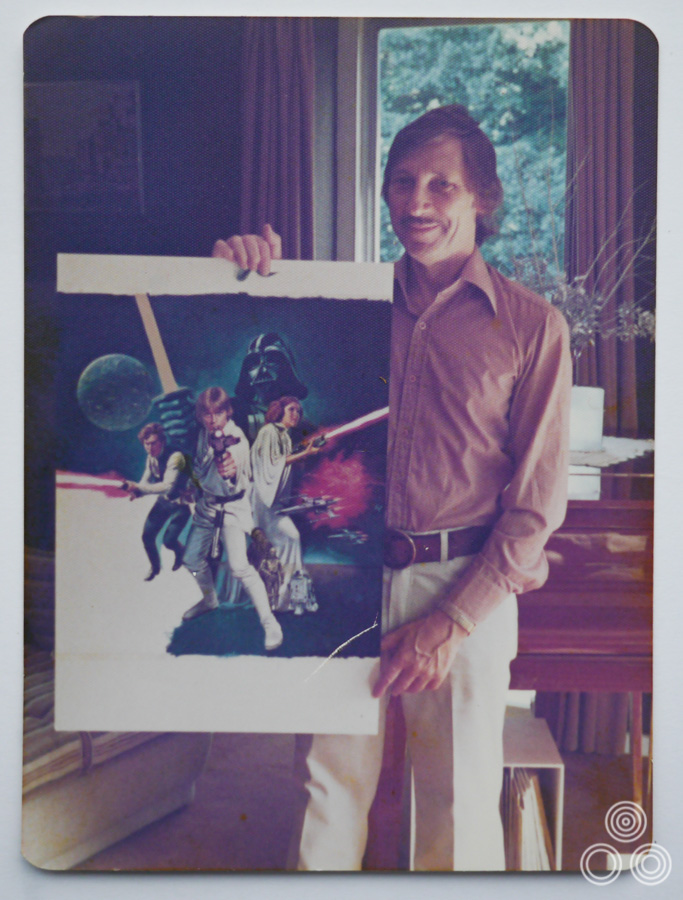
Tom Chantrell stands holding the near-finished artwork for Star Wars, arguably his most famous work. Photo taken by his wife Shirley in 1977.
It’s hard to believe today but it took over two decades before Tom accepted that his work was of any significance, having spent many years feeling that he was ‘just’ a commercial artist moving from job to job. It took the encouragement and dedication of one woman to make Tom realise that his artwork was something worth treasuring. That woman was Shirley Chantrell, his second wife, the mother of his twin daughters, Jaqui and Louise, and his constant companion for just shy of 40 years. Shirley herself has had something of a remarkable life from her beginnings as the daughter of a horticulturist in Singapore, with a brave and fateful voyage to London just shy of her 18th birthday that eventually resulted in a chance meeting with Tom, altering the course of their lives forever.
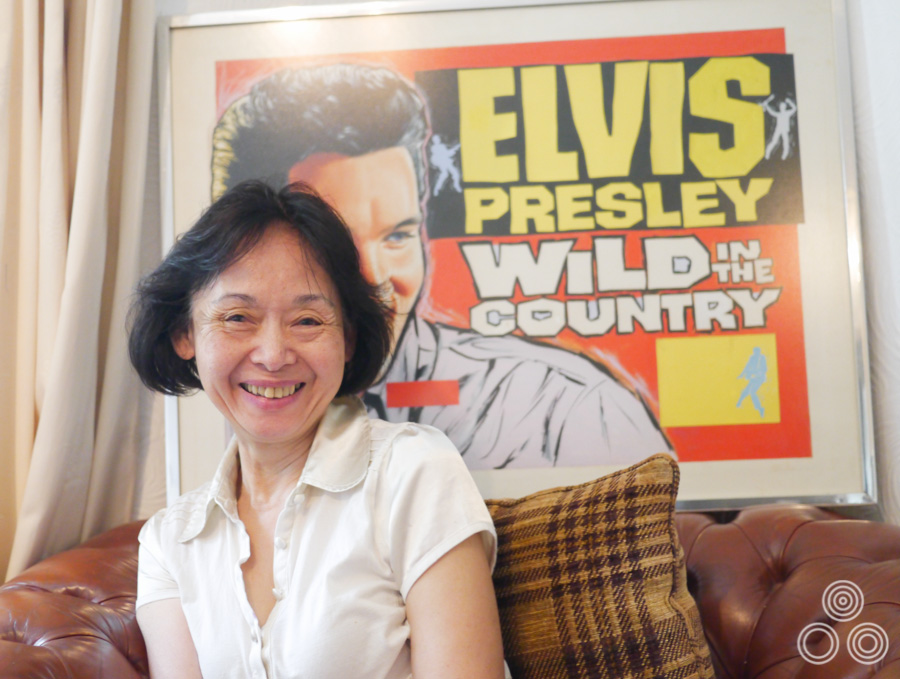
Shirley Chantrell sitting in front of the original artwork for the Elvis Presley film Wild in the Country, which was painted by her late husband, Tom Chantrell. Photo taken August 2012.
Although Tom passed away in 2001, Shirley’s insistence that his work had value beyond just the payment he received for it meant that the Chantrells had amassed an archive consisting of over 40 years worth of material, including original artwork, sketches, posters and plenty of reference items that Tom used to create his work. Having carefully preserved this material since Tom’s death, Shirley decided it was time to share the archive and allow fans of his work to view and purchase select pieces. Last year Chantrellposter.com was launched in collaboration with the respected memorabilia dealer Michael Bloomfield and the result is a treasure trove of Chantrell artefacts that is well worth a visit.
Over the past two years I’ve had the privilege of spending time with Shirley and from our very first meeting it became clear that her life story was intrinsically linked with that of her husband’s and that hers had been no less remarkable. Furthermore, I knew that it was a story worth sharing with others and this resulting article is intended to give the reader an insight into Shirley’s life and the four decades she spent with Tom. I have included plenty of never-before-seen photographs, including some amusing reference images that Tom used to create his work.
Shirley, I’d like to start with your early life, if I may. You were born in Singapore?
Yes, in 1944, the year before peace!
What did your parents do?
They were originally from China and my father worked in horticulture and he used to grow seasonal flowers for wholesale. My mum helped with the business and together they would tend to the plants all year round. If there were a big festival coming up they would be calculating how long it would take each flower to get ready for the show and plan everything meticulously. They were growing flowers like Dahlias and Gladiolis and I remember the bulbs were from countries like Holland. Even at a young age I was keen to know all about these other places that seemed so mysterious to me.
My father used to look after European family houses and he used to grow these lovely flowers in the gardens. He would enter competitions by sending them off to exhibitions and he was so good at it that he actually won several Silver Cups, which he was really proud of.
I remember that when my father was making deliveries around the city he would place me in this big basket that was full of all these flowers, and he would cycle it around with me sat there in the middle of these beautiful colours. I have this vivid memory of a time he passed by the Singapore River to show me these huge boats and we rested and had a coffee together by the waterside.
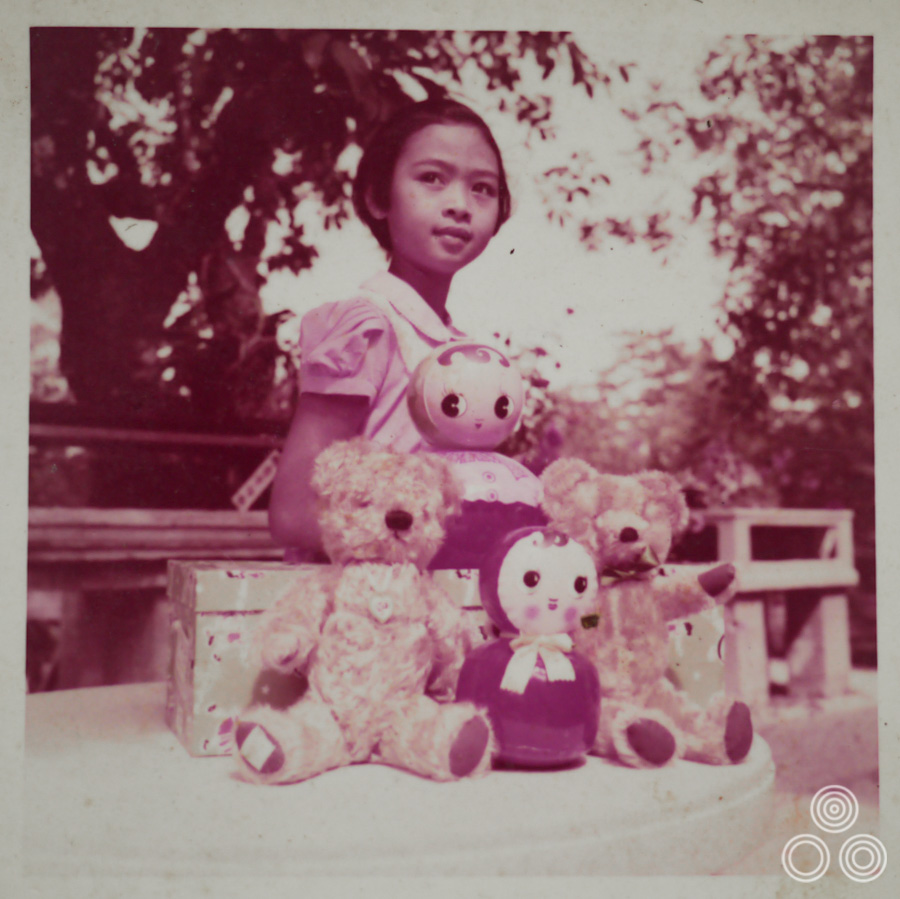
Shirley Chantrell stands with a selection of toys, aged around 6. Shirley: ‘These weren’t even my toys – I think they belonged to the children of one of the houses that my father looked after!’
You were one of how many children?
I was number six and my mum actually had nine in total. My brother is the eldest and then there are two sisters above me but there were originally two boys who sadly didn’t live past the era of the Japanese occupation of Singapore; they perished because of a wartime epidemic. Below me I have three sisters.
So you were born at the end of the war? Did you understand how tough things had been during it?
Well my mum made it clear that food was scarce. I think they were lucky though because my brother was already eight or nine years old whilst the Japanese were there and he was clever enough to learn to speak their language. They really liked that and used to give him bags of rice, which really helped our family.
When the Japanese came my family were really worried that they’d see we had a connection with those European families – especially the English – so my father actually hid the trophies he’d won in a pond because he’d have been punished if they’d found them. After the war he couldn’t find the trophies again so they must have been taken or gone rotten maybe.
Back in China my grandfather actually had two wives and my father was the youngest son of the second wife, so when my grandfather died my dad was given nothing because the second family weren’t allowed to inherit anything. My father was mad at this so he left China for South East Asia to start a new life. In order to be able to do this the people in the village where he was from were very kind and they all made a collection to pay for his passage to Singapore. He arrived there and used the skills he’d learned in China to open up this virgin land he rented in Singapore and that’s how he was able to grow his flowers.
He never used to wear rubber boots or anything on his feet and he contracted this parasite called Hookworm. It’s really nasty because it gets in through the soft skin on your feet, works its way into your stomach and then into places like your lungs. I think this really affected my father and I remember him being very weak. He died when I was six and for several months before then my mother had been doing most of the work. He’d make the delivery of the flowers but then come back and sit because he was too tired to do anything else.
I remember the day when he died; it had been raining heavily for days and I vividly recall my mother having to wade through floodwaters to get to the hospital to register his death. He was only 56 when he died. Everyone around me was crying but I steeled myself not to cry and I remember worrying about what our family would do for money. It was up to my older brother as the man of the house.
Before he’d died my father had also got a job at the council garden department tending to the flowers in their gardens and he was working with some real experts, including horticulturists who had come over from Kew Gardens in London to work there. A few months before my father passed away he managed to get my brother in there as an apprentice gardener. It was great because he learned a lot from these experts from England and other places. He started to grow orchids and eventually specialised in them; after a few years he became an exporter and was sending these orchids all over the world.
Were you able to go to school or did you have to join in and help with the family business?
I didn’t go to school until about three years after my father passed away. Before he died my father had befriended a monk and had been convalescing in a Buddhist temple for several months. It was this monk who actually made a collection to be able to pay for my father’s coffin and for the funeral. I actually ended up living at the temple for two or three years. I would have been about seven at the time and every morning I would sweep the temple and do washing up after every meal. It wasn’t nice but they were looking after me.
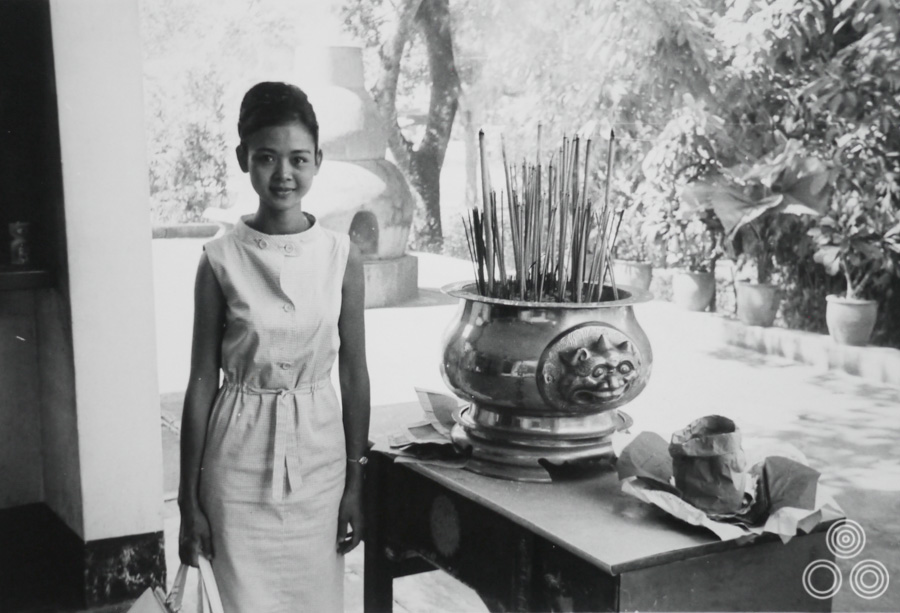
Shirley Chantrell standing in a Buddhist temple in Singapore, aged around 16. Shirley: ‘This is a photograph that was taken when I returned to visit and say hello to the people who had been looking after me.”
While I stayed there my mother would visit all the time and after a couple of years I wanted to go home so much that my mother decided to take me back. She talked to my brother and they decided it would be better for me to go to school, so I began my education in a Chinese school and stayed there for about seven years. We learned Chinese and English as a second language, as well as the obvious subjects like Maths and Geography. We also had classes on morals and how to be a good citizen.
Was there a subject that you liked the most?
Yes, I really loved the music class where I learned how to sing. I had this teacher who had graduated in England from the Royal Academy of Music and she took a liking to me and would always help me and single me out as one of the best singers in the class. She also encouraged me to join a choir, which I really liked. The teacher’s name was Ling-Li and she had been an entertainer after the war, singing in one of Singapore’s most popular clubs.
You ended up coming over to the UK. How did that come about?
That happened thanks to Ling-Li and her husband who was a professor teaching at Nanyang, the big Chinese university in Singapore. They were travelling over to England so he could work on his PHD and Ling-Li asked me if I wanted to come with them. I told her that I had no money but she told me that I didn’t need any money, only courage. She offered to lend me the money so that part of it was taken care of. The whole thing was a bit complicated, though, because I think that what actually happened that she wanted me out of the way.
There was a teacher called Mr Chang who had recently graduated from the Chinese University, and I think that Ling-Li had a crush on him. She had found out that I was seeing him after school and going swimming and to concerts with him and she told me that I wasn’t good enough for him and that I’d be better off going to England. She said that if I studied abroad I could improve myself so that I’d be up to his standards and then I could return to him.
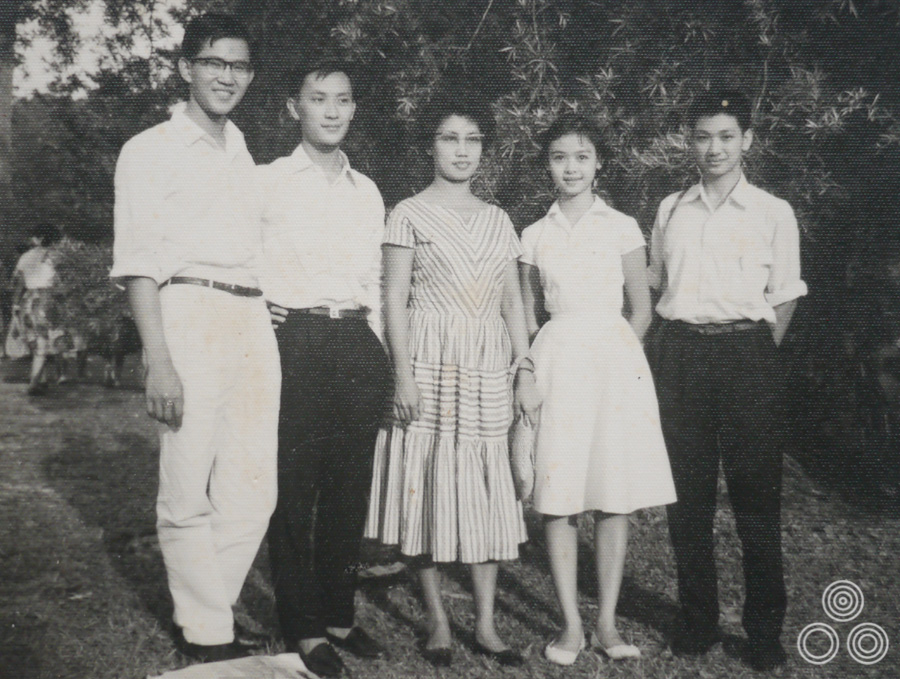
Shirley Chantrell stands with some of her classmates and the teacher Ling-Li (centre) in about 1960.
In other words she was trying to remove you from the equation?
Yes, she kept telling me that I wasn’t good enough for him and that she’d be happy to pay for my trip over here, so that’s how I ended up making the trip. Anyway, I was lucky to get to come here, as it’s obviously how I met Tom!
The journey over here to England was quite a long one?
Oh yes. It was on-board an Italian ship called the Flotta Lauro and it took three weeks to sail to Genoa in Italy, and from there we took the train all the way to Victoria Station in London. I left Singapore on the 8th of April 1962 so I must have arrived here just before my 18th birthday.
You met some interesting characters on the journey?
Yes, there was a French man who was an artist and he gave me this illustration that I’ve kept to this day of a town scene he’d painted from memory. I had a great time meeting all these interesting people who were all traveling back to Europe from Australia.
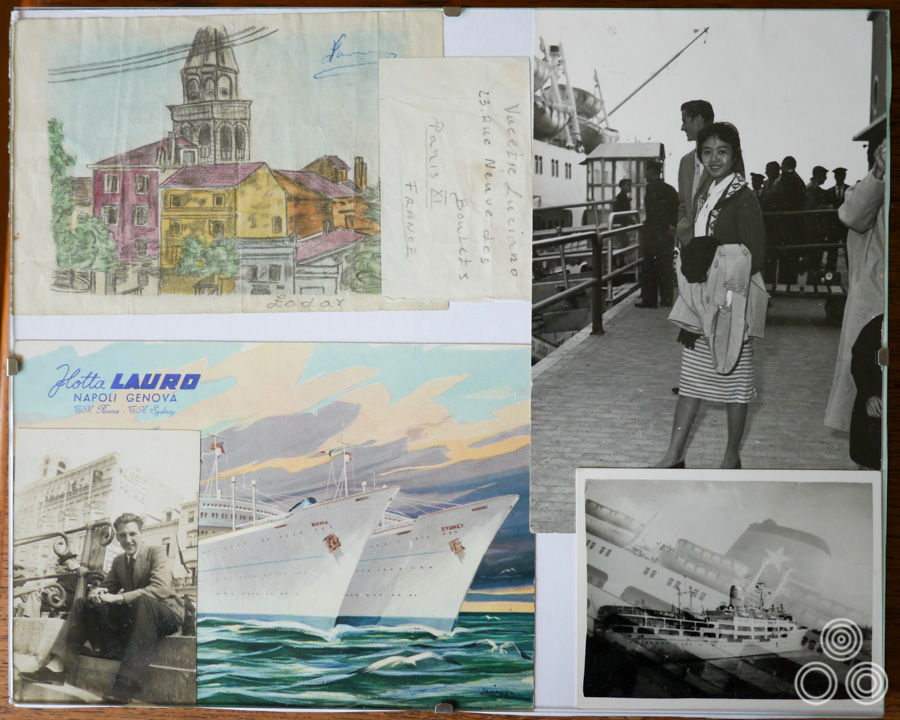
A framed montage of items related to Shirley Chantrell’s fateful voyage from Singapore to Europe, including a picture of Shirley on the deck and a sketch that one of her fellow passengers gave to her.
Arriving in London must have been quite an experience?
Oh my goodness, yes! When I walked out into the station I thought people were flying they were moving so fast! There were people everywhere just zooming past me and I didn’t know where I was going so it was completely overwhelming to start with. Ling-Li had booked us into a youth hostel for the first few weeks until we were able to find a house to rent. It turns out that she had influenced a few other students to make the journey from Singapore so we were all together.
Ling-Li wanted me to study English as well as mathematics and art as O-levels. Once I’d passed these, the original plan was for me to return home but obviously that didn’t happen after I met Thomas William Chantrell!
How did that come about?
Well Ling-Li had encouraged me to join an evening class for art and I went along. I was working at a restaurant on Argyle Street called Jolly and after work I’d go straight to the class. After a few classes I began to notice this gentleman who stood out in the class. I quickly realised that he knew what he was doing and I thought I’d better start watching him!
So that’s how you struck up a friendship?
Yes, I think we were both curious about each other but at that time I couldn’t even speak English so it wasn’t like we could have long conversations. We started getting along anyway. I remember that the class was on a break over the Christmas period and when we started again in January he asked ‘Did you miss me?’ I didn’t understand what he meant so I just nodded politely and later that evening I checked my English/Chinese dictionary. It was only then I understood that he was asking if I’d been thinking about him.
When he told me what he did for a living and showed me some of his posters that were pasted up on the underground, I was in complete awe and couldn’t believe that an artist like him would want to even speak to a nobody like me!
We started to go for coffees after class and I just thought he was a nice friend. At a certain point Tom had managed to arrange a job for me working at Warner Bros where I was splicing and repairing film. It was in an office near to the Berwick Street market and at lunchtime all the ladies who worked in that department would go shopping and then return to the office to compare the food they’d bought on the market. I still couldn’t understand a lot of English but I used to listen to them yapping away about their ‘nice cuts of meat’!
Your English must have been improving every day?
Well it was getting better but was still not quite good enough so I was attending evening classes to study it further. I got a job working in a branch of Littlewoods that was directly below the offices of Allardyce Palmer where Tom was the creative director. We often used to meet up at lunch so I wasn’t just seeing him during the art classes. I remember it being quite a big deal to get a job at Littlewoods and I even had to take a test to prove I was up to it.
What kinds of things were they testing you on?
It was all about being good at mathematics and dealing with the ladies who shopped there in the correct manner. I was good at that job and I think my manager liked me because I had a lot of initiative. I was working in the millinery department, selling hats, and if a popular item sold I would always make sure it was replaced quickly. This meant that the sales rose and it made me look good.
I distinctly remember the buyer for the department, Mrs Bridge, a very stylish lady who always wore fur coats and hats, asking me how I was able to increase the sales so much!
How do your relationship develop?
Tom was married at the time so things developed very slowly. Eventually Tom left his first wife and to begin with we stayed in a bedsit in Golders Green and then we moved to a flat in Cricklewood. In 1966 we bought our first house in Dulwich; a five-bedroom place that was so cheap for the time – it was £6100, which was nothing really. Our twin daughters Jaqui and Louise were born whilst we were living there.
We sold the house in 1972 for a nice profit and it meant that Tom no longer had to go into the office to work, he could paint at home in his studio. I don’t think he was very happy with the account executives at Allardyce Hampshire at the time; they weren’t giving him good instructions for the work he was doing. A new manager had started there who didn’t know Tom and how he worked and had started complaining that he wasn’t arriving at the office on time and things like that. At a certain point Tom told them that they should let him go, give him a golden handshake pay-off and then he would work for them as a freelancer.
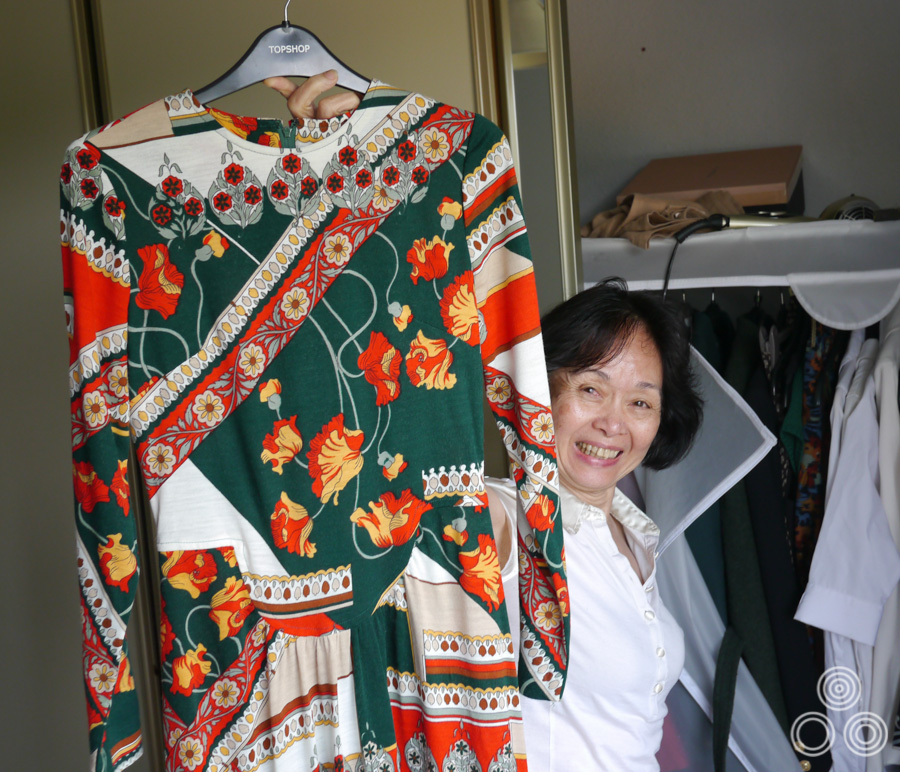
Shirley Chantrell holds up her wedding dress, still as bright as the day it was worn 38 years earlier. Photo taken in 2012.
Was he immediately much happier?
Oh, definitely! He really loved not having someone standing over his shoulder hounding him for the work. He enjoyed working odd hours, sometimes overnight if the job demanded it, but he always made sure it was delivered when he promised. I remember getting woken almost every morning at around two or three when he came to bed!
You’ve mentioned before that it wasn’t until you and he got together that he started to care about his work in terms of it being something worth keeping and archiving?
I’d always appreciated art and I was enthusiastic about Tom’s paintings. Of course it was his job, and not just a hobby, but he still cared deeply about the work he was doing. When I first moved in with him there had been this huge pile of posters on the floor and I had asked him what they were. He told me that they were his reference artwork from his portfolio that he’d show to people when he was looking to get a freelance job.
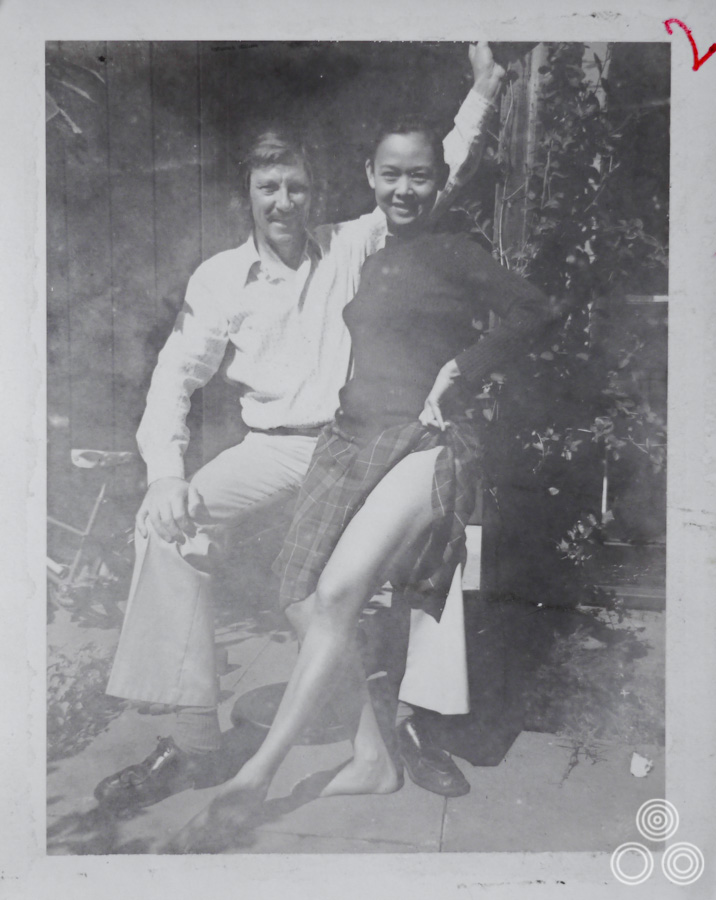
Tom and Shirley pose together for a reference image, likely to have been used by Tom to paint part of a poster, in around 1966.
He wasn’t taking very good care of them so I decided I’d make sure they were looked after for him. I put them in folders and carefully made sure all of the pieces were together. He’d cut some pieces up where he wasn’t happy with certain parts or if he’d worked with someone else on a poster so it was a total mess. I wanted to make sure that he wasn’t losing any of it or letting it get damaged beyond repair.
It was around this time that Tom started to ask the printer for one or two copies of every poster he designed or painted.
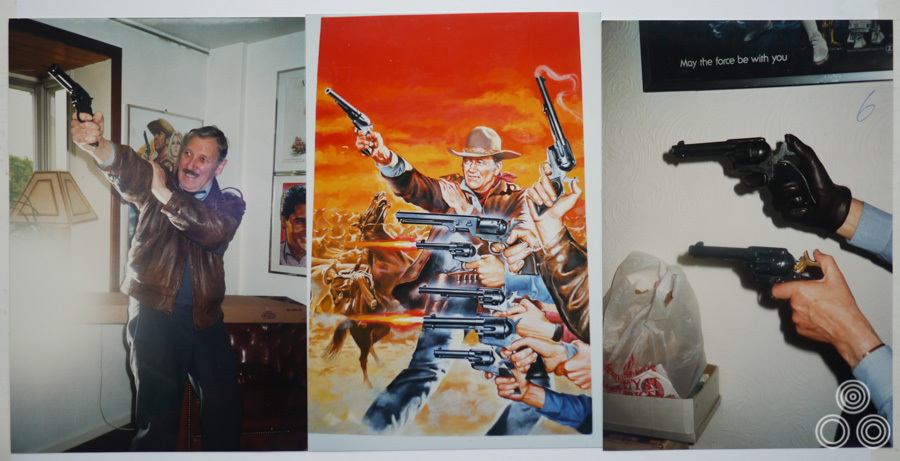
A montage of images showing how Tom Chantrell would use reference photos (often taken by Shirley) in the creation of his work.
I understand that you started work as an actor?
When the girls were about ten and we thought they might like to try acting. We’d met this chap who was a TV showbiz entertainer after Tom had happened to sell this caravanette we owned to him – I can’t remember his name I’m afraid! Anyway, we’d asked him how we could get Jaqui and Louise some parts on TV, or on a film, and he suggested we buy a trade magazine called ‘The Stage’.
So we bought a copy and it includes lots of different advertisements for theatre plays, TV shows and more. There was this one advert that was looking for a ‘singer wife’ for a production of ‘The King & I’ and I said to Tom ‘that’s me! Let me try!’ I’d been going to singing lessons every week because I wanted to keep it up so I didn’t lose my voice. I asked Tom to write me a letter and send it in for me.
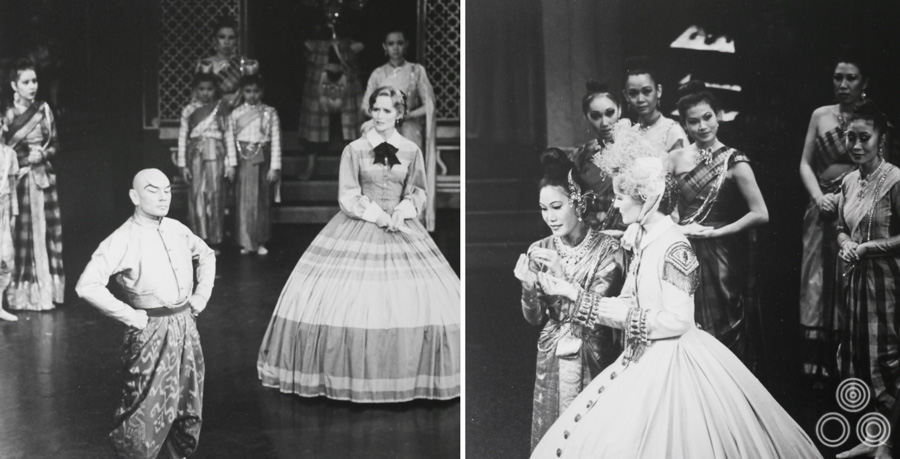
Two images from the stage production of The King and I starring Yul Brynner, which featured Shirley Chantrell.
I ended up going to the audition and they asked me about myself so I told them that I was a housewife with twin daughters and that’s when they asked me to bring the girls along for an audition for roles in the King & I musical. I ended up taking them along but they were actually too tall for the role and they couldn’t use them. The part of the wife had to be taken by a short lady because Yul Brynner played the King and he’s only 5 foot 6, so they had to be shorter than him. Apparently there were over 2000 singers that had auditioned for the part and I had come very near the end of the casting process. I was one of the last two and I got in! I ended up singing in the musical for an eighteen-month run at the Palladium Theatre on Argyll Street.
Did you enjoy the experience?
To tell you the truth, I really wanted the job, but it was nerve-wracking and for three months I had really bad stage fright. Every time I walked on to the stage it felt like my heart was going to stop! I told Tom about it and he suggested I went to see a hypnotist, which I did. I think I saw him about 10 times and he really helped me by talking through various things I had on my mind. He put things in perspective for me and calmed me down.
I remember I was particularly scared before the Royal performance and he told me that I had nothing to worry about. He said Princess Margaret is no different from anyone else and he reminded me that she was suffering herself with the divorce she was going through at the time and probably just wanted to come to the play to take her mind off things and enjoy herself. Just by talking things through with him I began to feel normal again.
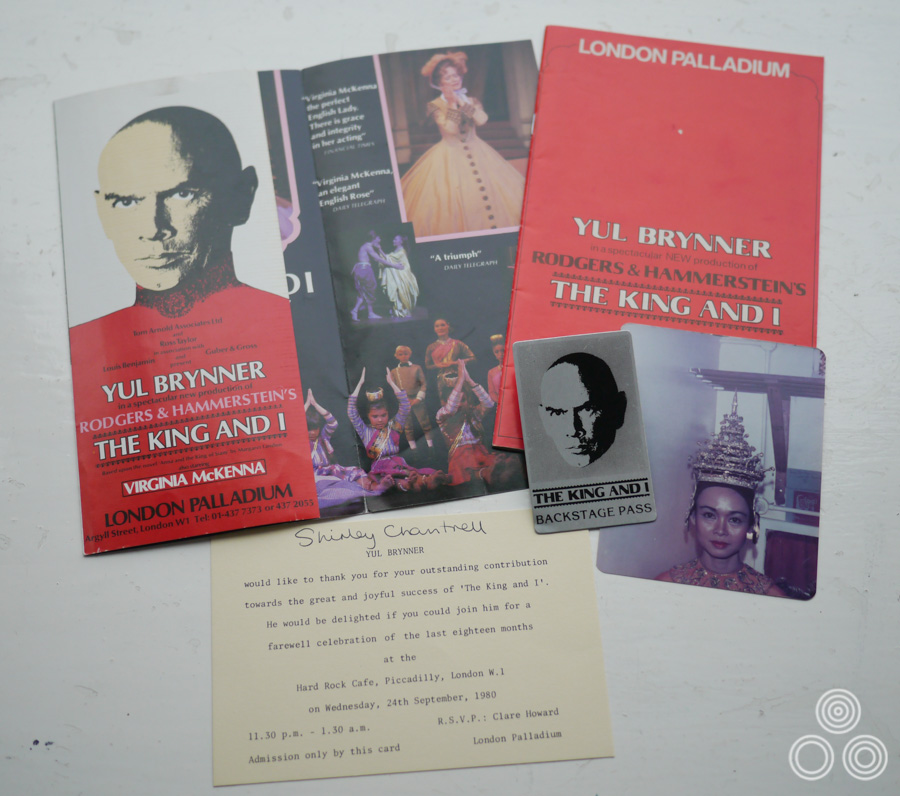
Ephemera from the theatre production of The King and I, starring Yul Brynner and featuring Shirley Chantrell, as pictured in costume in the bottom right.
Did you get to know Yul Brynner?
Yes, and he was a King all right! He was a powerful presence and people were in awe of him. I recall that there was a phone back stage and sometimes it would ring and you could hear it whilst you were performing. Yul had requested that the theatre manager remove it because it was distracting him, but after four days it was still there and so he just walked up to it and yanked it off the wall! Theatres used to be pretty dusty and grimy behind the scenes and I remember that he requested his dressing room be completely redecorated.
The play really took it out of me and by the end I was quite ill. I’d been working six days a week and used to go to the theatre at 5pm each day when most other people were thinking about heading home. It meant I had practically no social life and only had time to look after my girls during the day. To be honest it put me off working in a theatre and I never did again afterwards. Looking back I will say that it was a character-building experience and it really helped my confidence. It gave me a lot more belief in myself because it was something I’d done on my own and I had been praised for it. Tom was really nice and encouraging of me.
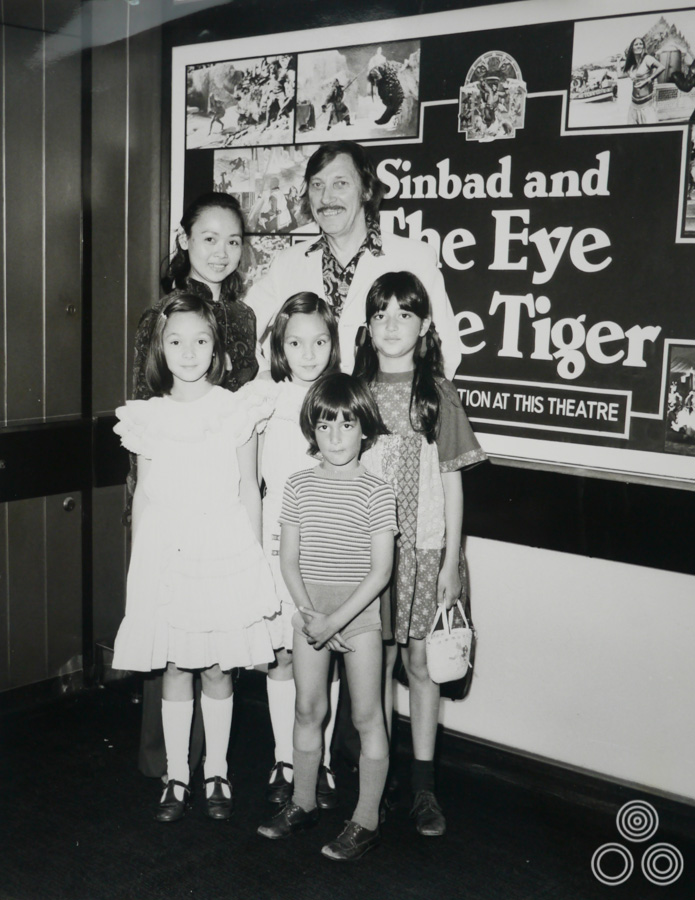
An image of the Chantrell family, plus two young friends on a trip to the premier of Sinbad and the Eye of the Tiger in 1978.
Just as you were very supportive of his work as well.
Well I really admired him and I tried to be the best wife I could be. This is how I felt; if I was going to serve somebody I wanted to serve someone worthwhile. When he heard my life story I remember him promising to look after me from then on and I felt very lucky. I remember when I was thinking about leaving Singapore I’d said to myself that even if I ended up as a beggar in England it would be better than staying where I was. There’s a Chinese proverb that talks about how never leaving where you grew up is like living in a well; you only ever see the same bit of sky. Fear can stop you following your dreams but I went for it and it was the best decision I ever made.
You acted in a handful of films too?
Yes, after I got my equity card from doing the musical I signed up with an agency called ‘Oriental Casting’ and I started doing television work, which was a lot easier. I didn’t have to spend months learning the lines for starters! I was doing a lot of walk-on and extras work but then I went for a film audition for Empire of the Sun, which is set during World War II. At first I was given a part as another extra but then they had trouble with a lady who was playing a cook in the Chinese detention centre. The problem was that she couldn’t actually speak Chinese so the director came to the group of female extras and asked if any of us could speak it, and I just put my hand up. He auditioned me in a scene where I was telling the little boy [Christian Bale’s character] off and he liked what he saw. I had my first film role!
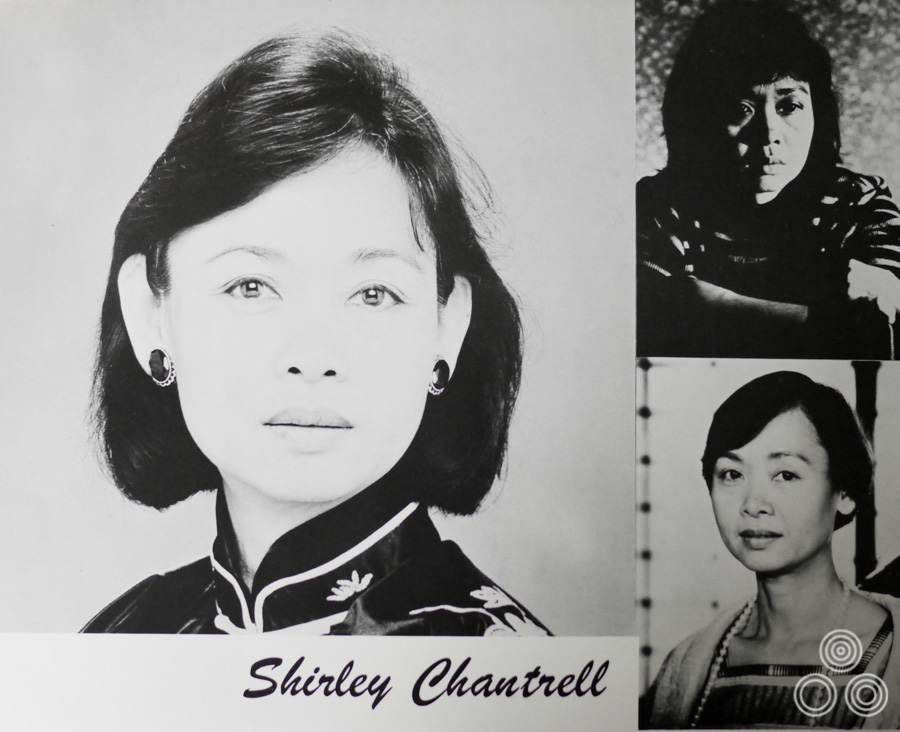
A card that was printed for Shirley Chantrell to sell her acting career to potential casting agents and filmmakers, circa the mid 1980s.
What was that experience like?
Well they were filming it in the London Docklands inside an old sort of coalbunker building, which was really dirty but it helped the authenticity of the scene. I have to say the pay was very good and much more than I was used to with my TV roles. I worked on more TV shows after that and then the next film I did was the costume drama The Wings of the Dove in 1997. After that came Tomb Raider: Cradle of Life in 2003.
What part did you play?
I was Lara Croft’s ally in China and I was a kind of secret agent who helped her to repair her motorbike and then gave her a selection of weapons. We had to give each other a hug and say ‘Ni-hao’ [Hello!], which was quite something! It was a fun experience. Eventually my acting agency went bankrupt and I just stopped working. There were too many people wanting to do it and I felt I was getting on so I was happy to stop it.
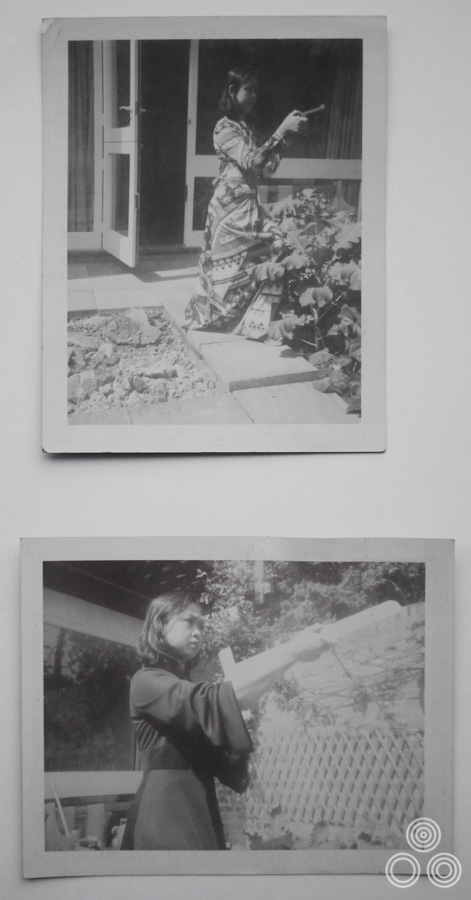
Shirley Chantrell poses in reference shots taken by her husband Tom to be used in the creation of one of his posters, circa 1970.
All along you’d been helping Tom by modelling for his posters
Yes, every so often he’d take photographs of me doing certain actions or in particular poses, which he’d then use for references. Our daughters helped him out too. Probably the most famous one I did for him is the Star Wars poster where I’m posing with a sword to mimic the pose that Princess Leia is making with a gun on the poster.
Tom was given an invite to the premier showing and we all went along as a family. As soon as he’d seen the film he had the synopsis, the 10” x 8” press stills and then he started to think about how he was going to tackle the project. From beginning to end it took one month, which is a lot of work for one poster. He’d never taken that long before and I don’t think he did again.
I guess at the time no one really knew the phenomenon that Star Wars would eventually become.
No, it’s true, but we had a strong feeling though, once we’d seen it, that it was going to be something special. Tom always had a sixth sense when something special came along and he really wanted to make the best of the poster. He’s very thorough when he needs to do a job; he’ll painstakingly work to make sure it’s right. If he’s not given a good enough photograph by the film’s studio he’ll make one himself.
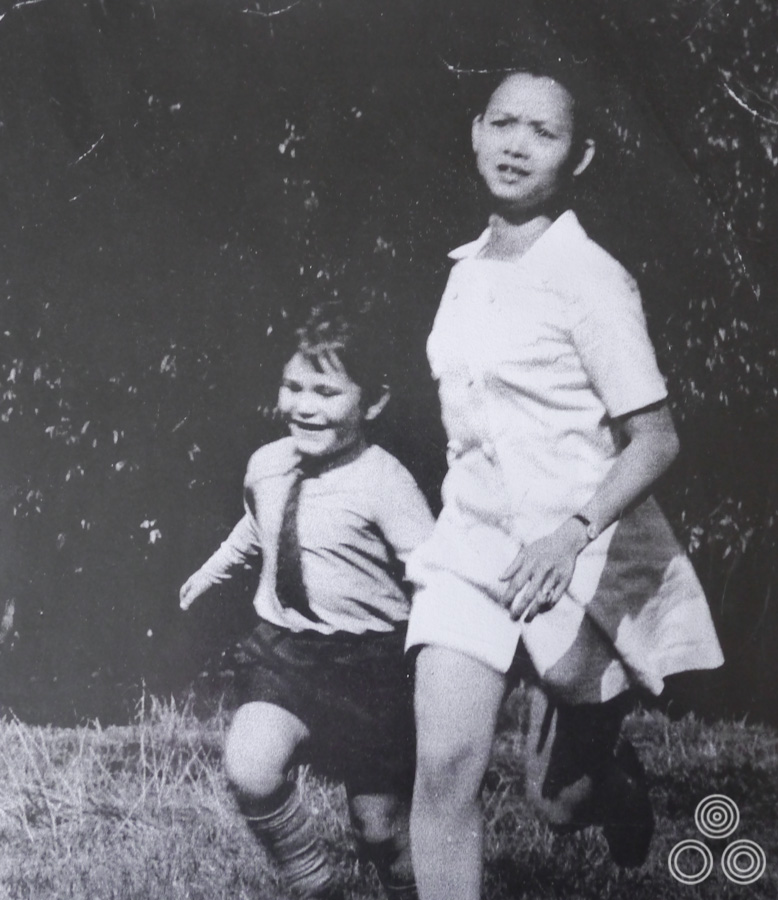
Shirley Chantrell and the son of one of her neighbours running in a reference shot used by Tom Chantrell to paint the British quad for Nicolas Roeg’s film Walkabout, circa 1971.
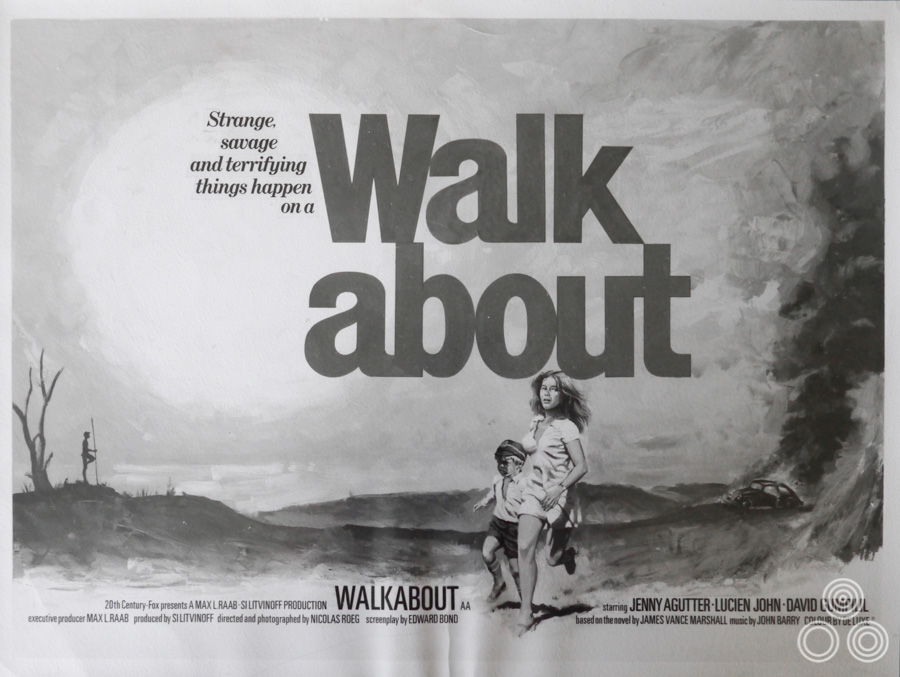
A black and white image of the Walkabout quad, painted by Tom Chantrell and using the reference shot above to get the poses of the running figures right.
There was a poster for ‘Walkabout’ that he was working on and I remember he picked the twins and me up after school and he drove us up to Sydenham Hill. He saw this mother with a boy and asked her if he’d mind if he took a photo of the boy running down the hill with me. The woman agreed and so the image of Jenny Agutter’s character and her brother on the poster was based on that photograph.
Tom would be given a brief for a poster and he’d think it over in his head how he was going to do and then when he needed a decent reference photo to paint from he’d grab his camera and work with colleagues, friends and his family to pose for the reference. Sometimes he’d even pose himself and get me to take the photograph!
What was it like around the time Tom was considering retiring?
Well for a long time he’d been in demand and many different studios and producers had specifically sought him out to do a poster for their film, but gradually he started doing less and less at the end of the 1990s. His eyesight had started failing him and he had also contracted diabetes so he wasn’t up for working the same kind of hours he’d been used to.
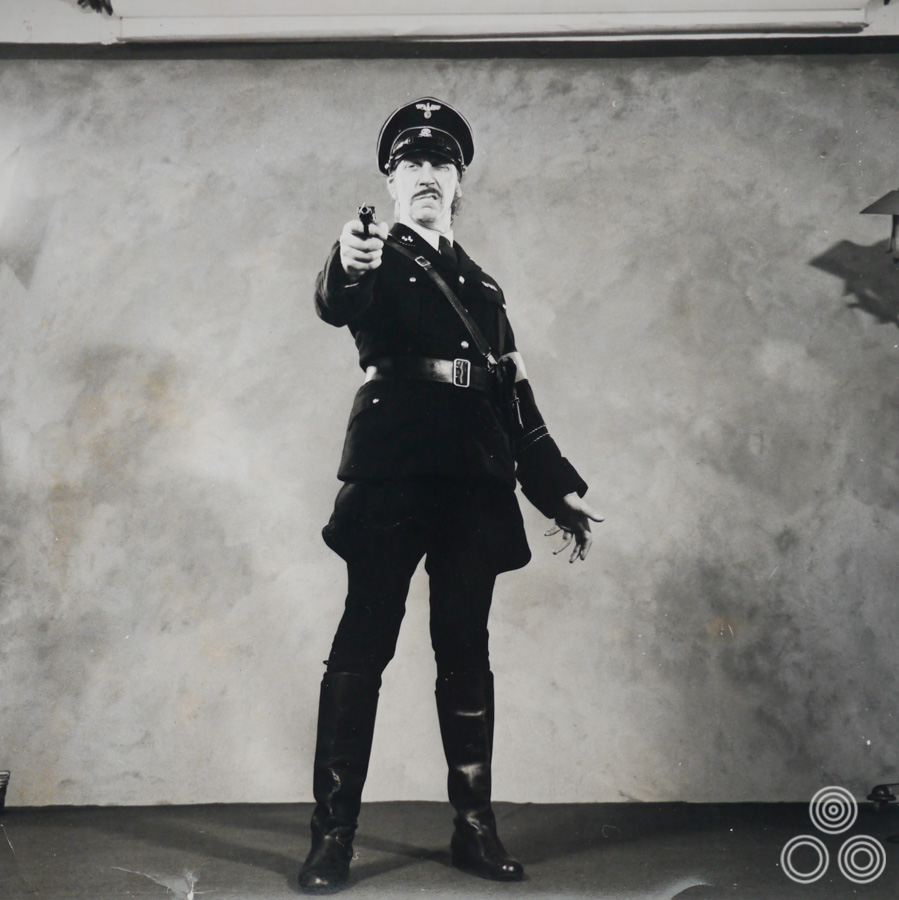
Tom Chantrell poses in a Nazi uniform in one reference shot from a sequence that would be used by him to paint the quad for the unmade Hammer Studios film The Savage Jackboot, 1972. See here for more details.
I remember that Michael Winner went after him to do a poster for a film he’d directed but Tom declined because he felt he wasn’t good enough any more.
How did Tom find retirement?
I think he was a bit fed up when computers began being used as a tool to create posters. He’d tried to use them and even bought a few books to learn how but he never did. It just wasn’t the same as sitting down and painting and in the end he decided not to bother pursuing it.
He spent his days looking over his old work and tried to restore and protect them; that’s why lots of his original art is in the condition it is. He attended a film fair and that’s when he realised that people actually collected his work. He was shocked to start with and couldn’t believe that people actually cared enough to seek out his posters. I’d been telling him for years that he should get a book together of his work and that there’d be a demand for it, but my word wasn’t good enough. He just didn’t think that anyone would care about it. It was frustrating but I couldn’t persuade him.
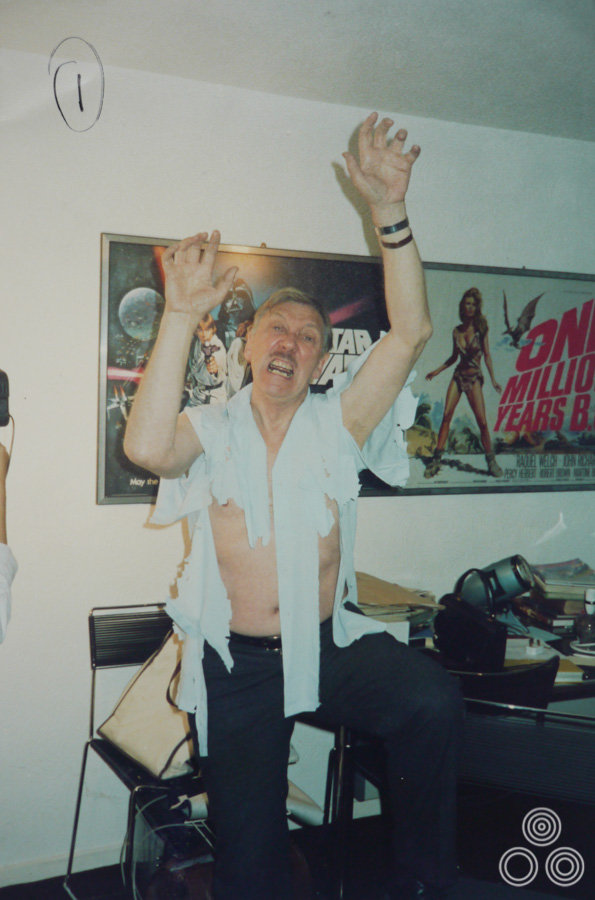
Tom Chantrell poses with a torn shirt in a reference pose that he would later use to paint one of his posters or video covers, circa 1986.
Can I ask you when you were both at your happiest?
The best time of our life was when I was pregnant with Jaqui and Louise. He was such an excited expectant father and was so kind and caring with me. We had no idea we were to have twins so it was a great surprise for both of us. Tom was tickled pink. He was at home when they were born and I called him to tell him and he didn’t believe me at first!
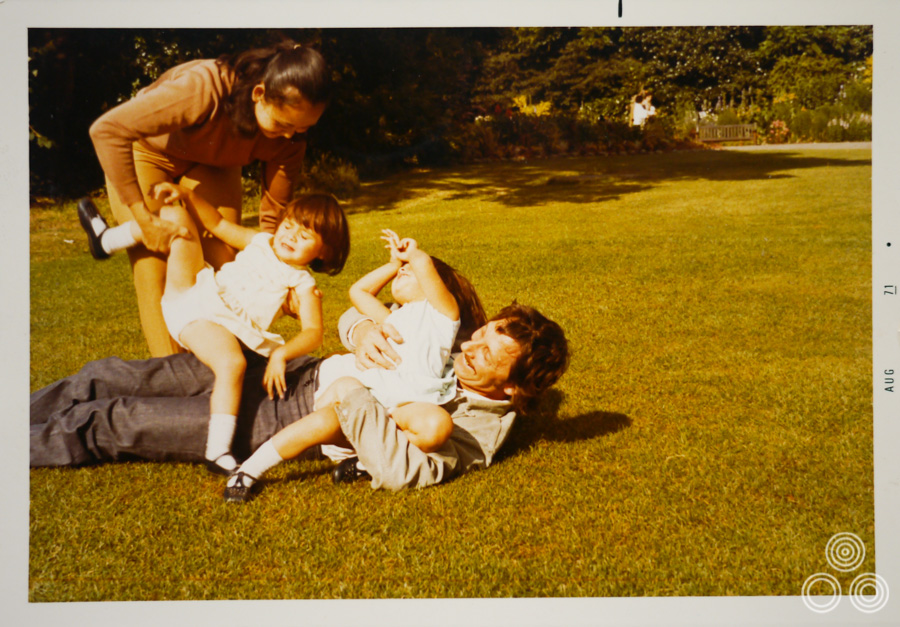
Tom and Shirley Chantrell play with their twin daughters Jaqui and Louise in a park near their house, August 1971.
I look back to when I was worrying about taking that boat from Singapore to come here and I’m just glad I went for it. Life just unfolds and you have no idea what the future will hold for you. You have to take a chance!
Thanks so much for your time Shirley.
You’re very welcome, thank you.
————————–
Visit Chantrellposter.com to read more about the artist and see a huge gallery of his work, and more.
To see the posters I have collected that were painted by Tom click here.
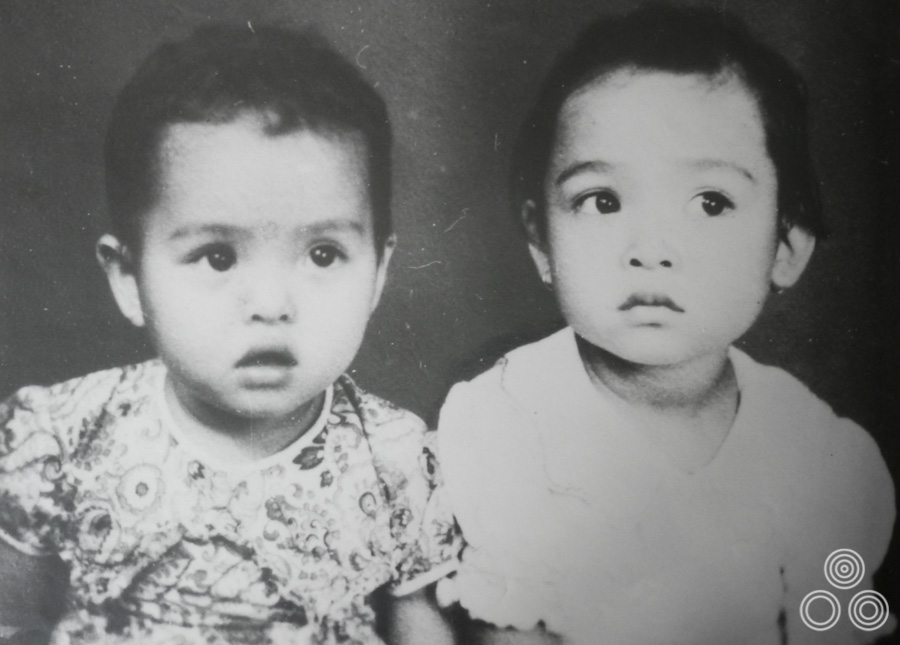
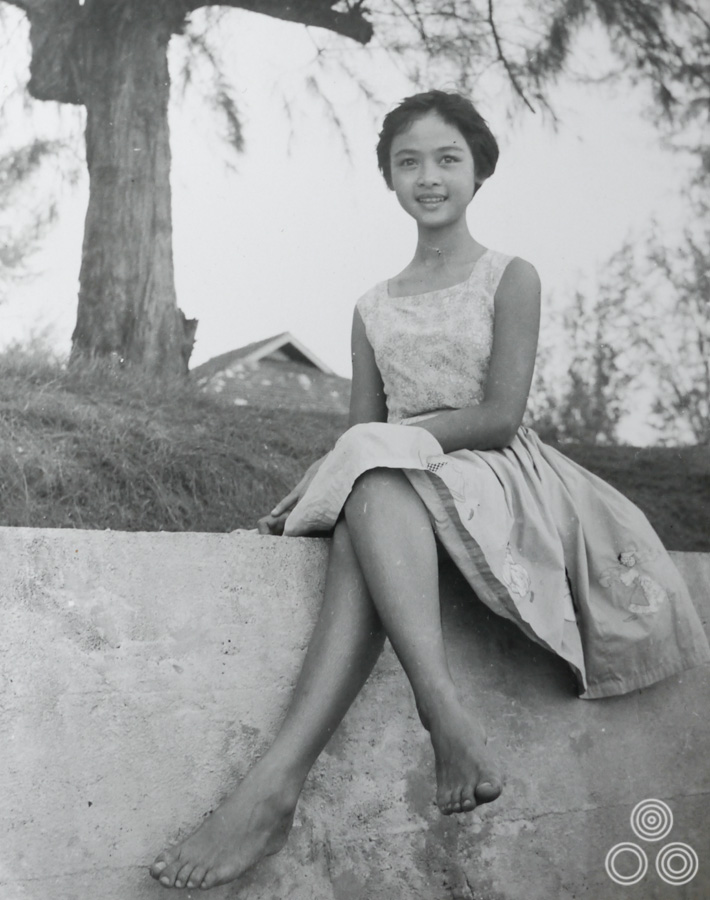
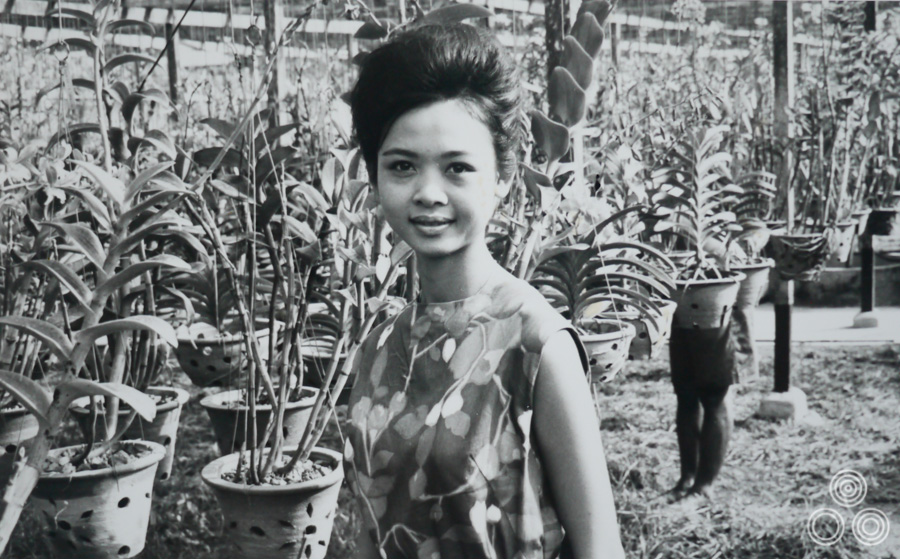
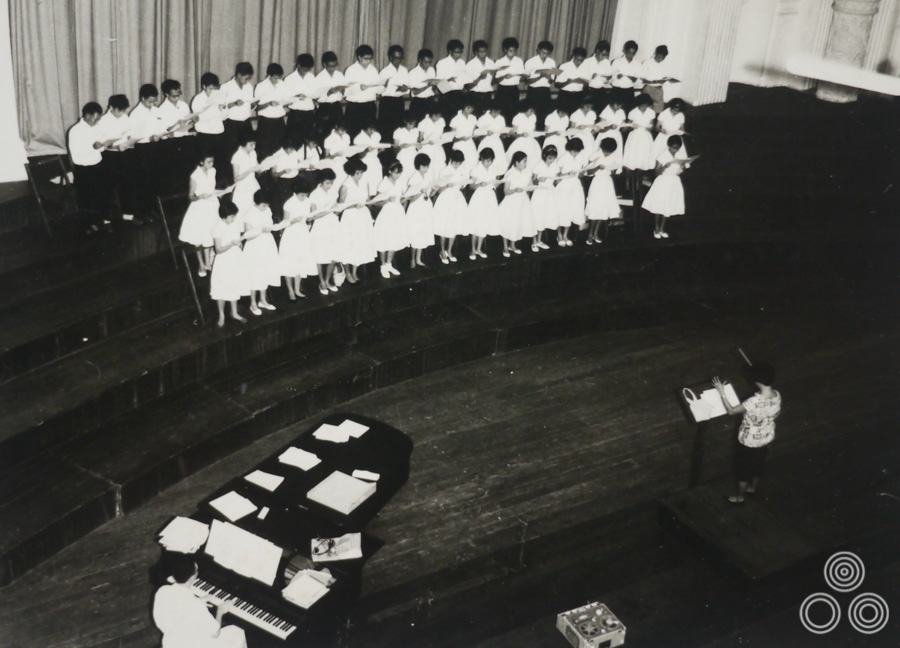
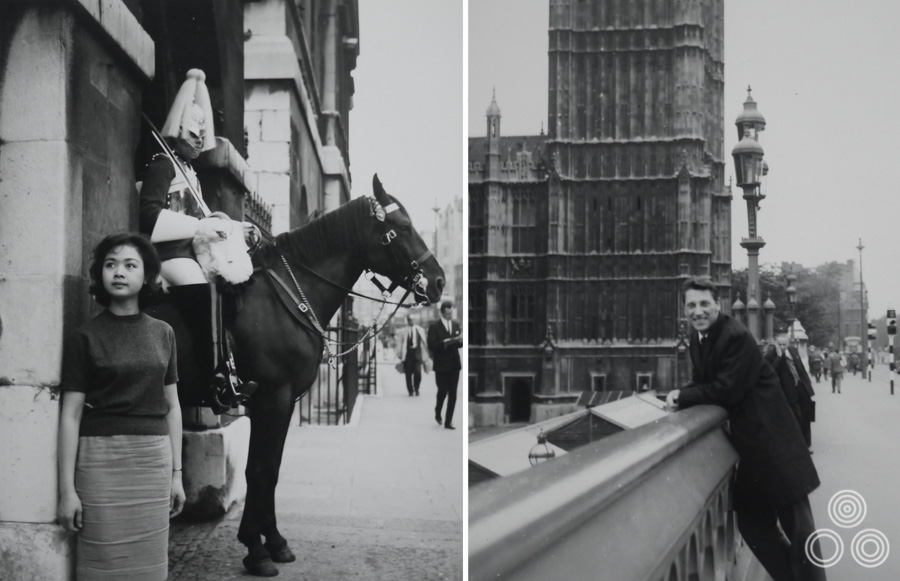
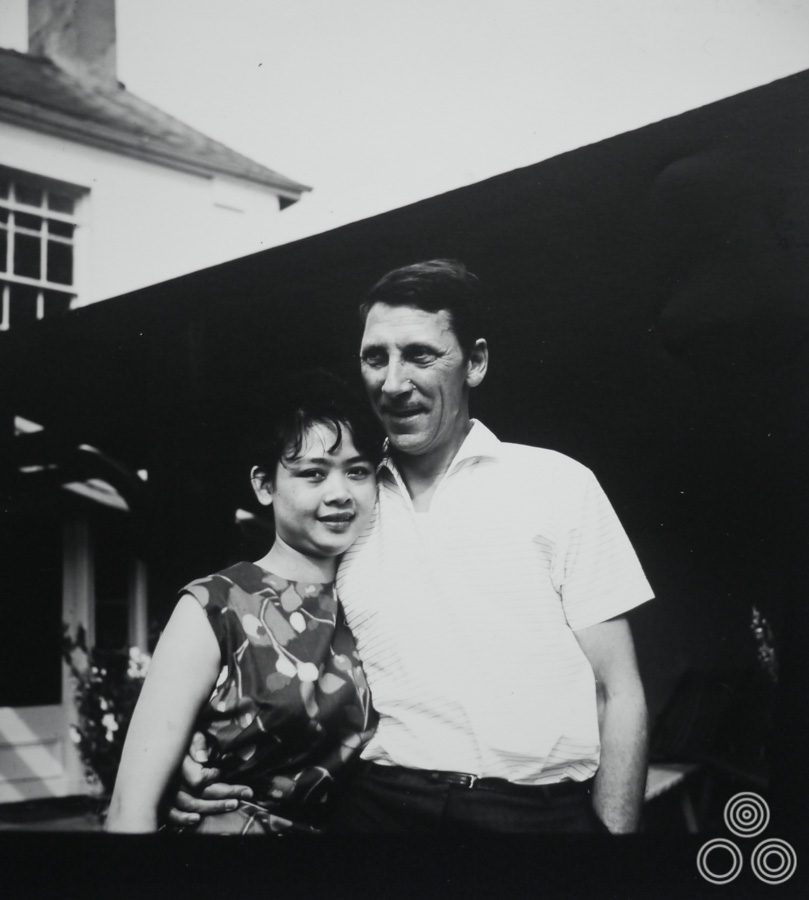
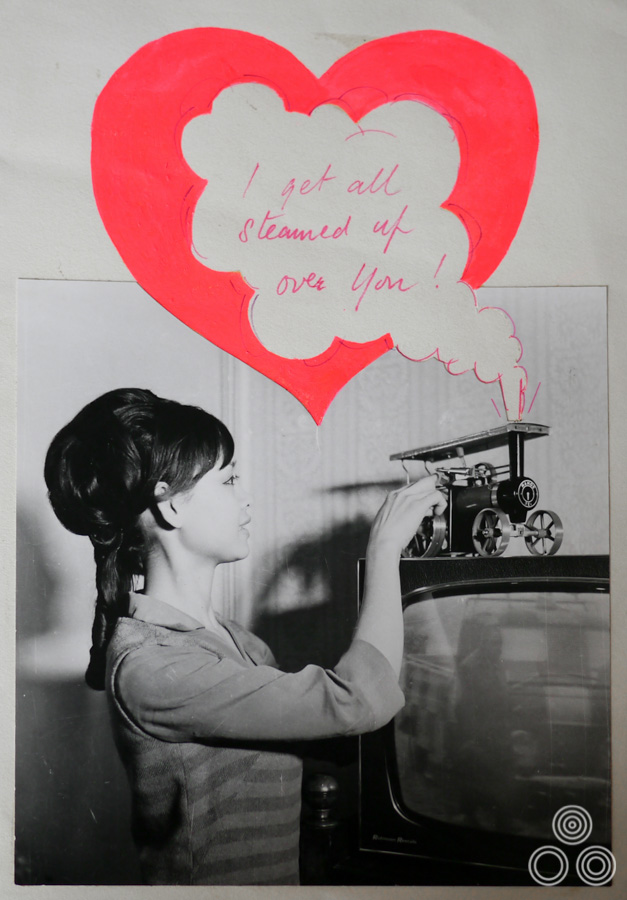
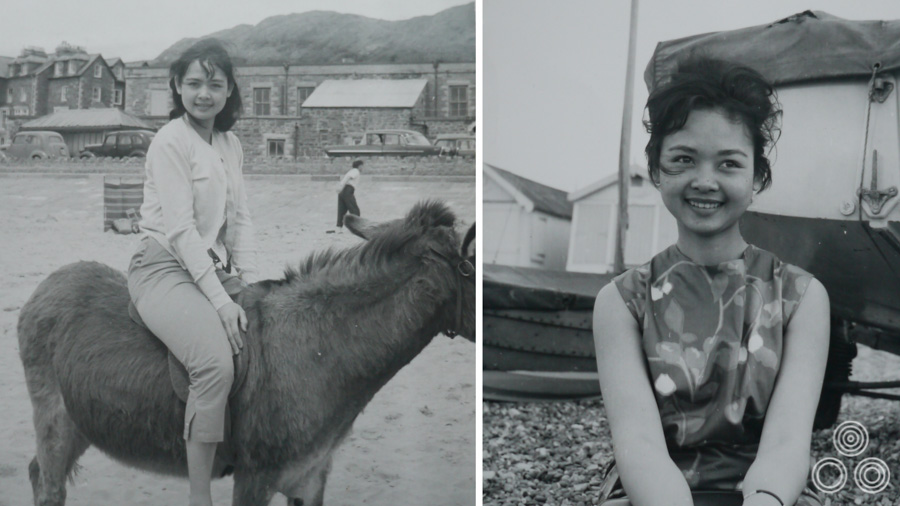
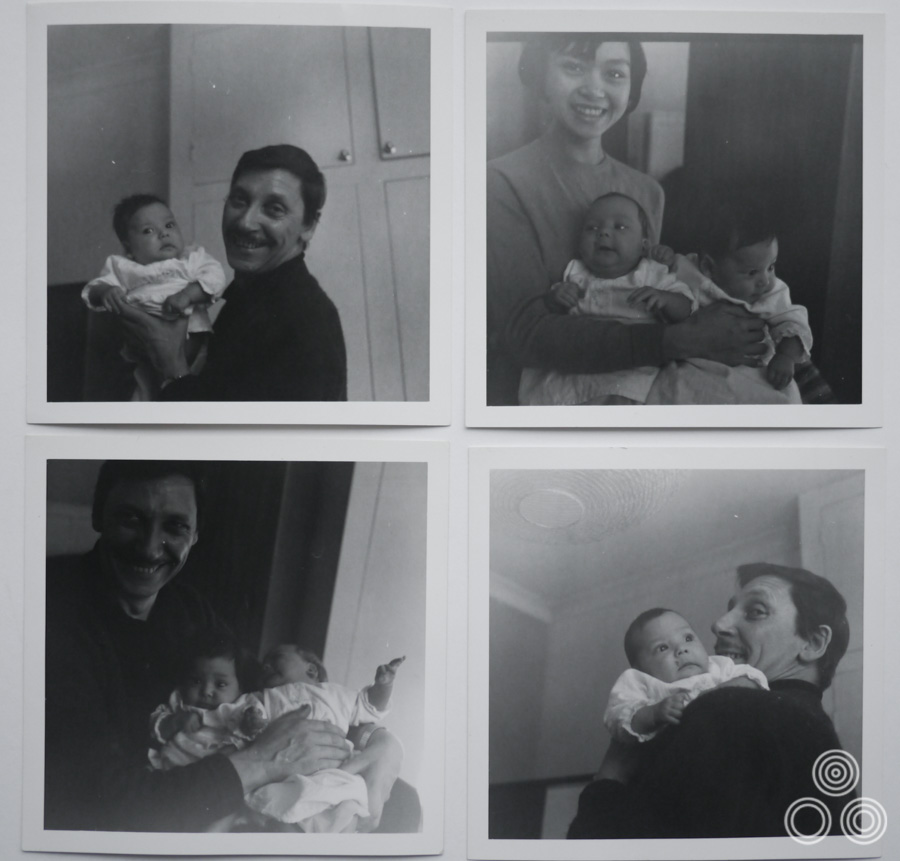
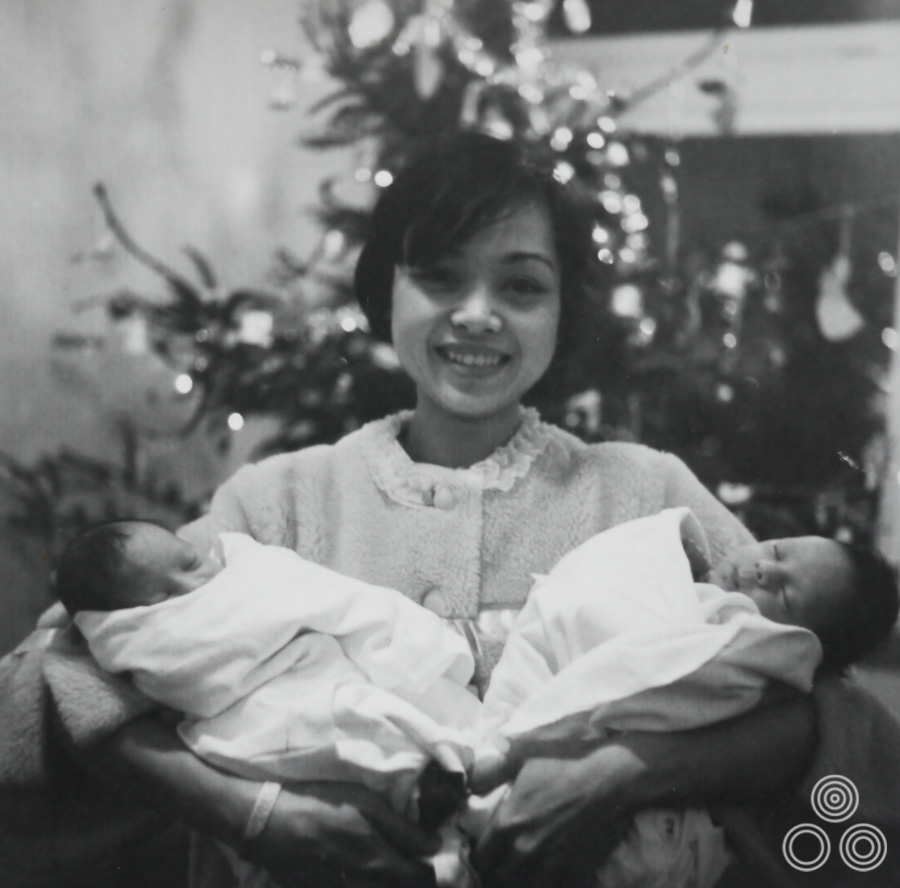
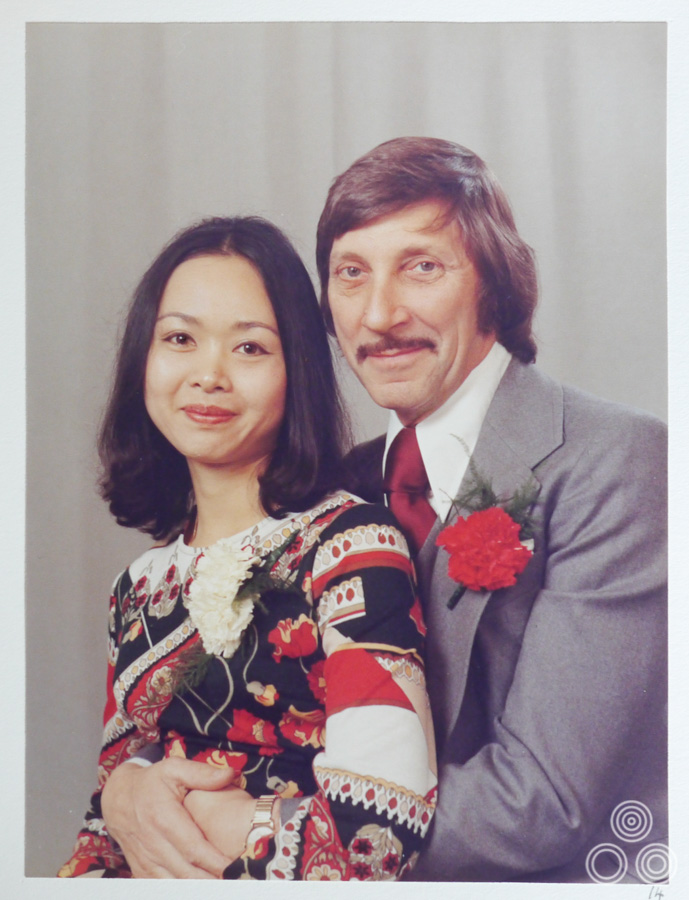
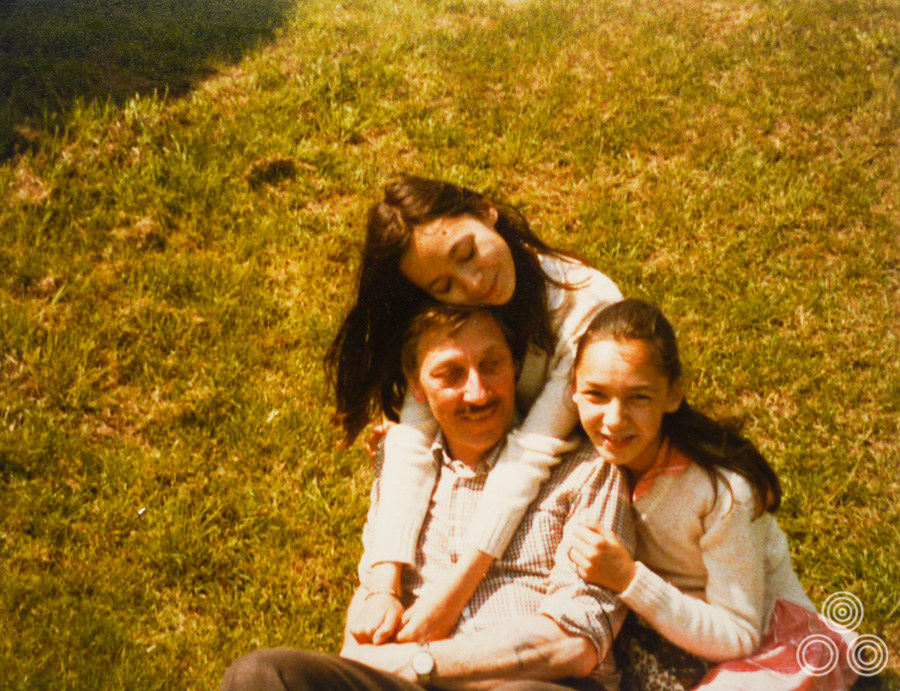
We’ll done! I had the pleasure of meeting Tom and Shirley at home in Croydon, and the privilege of being taught a one week ‘crash course’ in film poster design by Tom subsequently, years ago. I have been a Chantrell fan since I was a kid in the 70’s.This article and interview is very special for me. A great thrill to read. – Thank you!
Loved reading your family history would so love to make base with you as i have been watching The king & I as a past wife of the 1979-80 cast at the London Palladium Makuini x
Thanks for this Ed and Shirley, was really a great story!